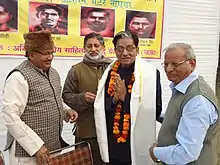Daya Prakash Sinha | |
|---|---|
 | |
| Born | Allahabad, Uttar Pradesh, India |
| Occupation |
|
| Education | Master's degree |
| Notable awards | Padma Shri |
Daya Prakash Sinha, also known as D. P. Sinha, is an Indian retired IAS officer,[1] currently serving as the national convener for BJP Cultural Cell and vice-president of Indian Council for Cultural Relations (ICCR).[2] He is also a director, writer, dramatist and playwright, known for his Hindi plays such as Samraat Ashok,[3] Seedhiyan, , Katha Ek Kans Ki, Itihas Chakra and Rakt Abhishek. He is a recipient of Padma Shri, the fourth-highest civilian award in the Republic of India.[4] His theatrical works have been published and staged for 50 years and translated into many languages.[5][1]
Career
Civil service
Sinha was born in Allahabad. After earning a master's degree, he continued to study for government exams. He couldn't clear the UPSC examination and joined Provincial Civil Service in 1952. Where he was promoted to IAS for Uttar Pradesh. In 1993, he retired as a director of cultural affairs. During his 4-decade long tenure, he held many cultural positions and promoted performing arts in India.[6] He also served as the chairman of Lalit Kala Akademi, Uttar Pradesh from 1986 to 1988.[7]
Theatrical literature
He developed an interest in theater from a young age. He started his performing arts career as an actor in a Laxminarayan Lal's play, Taj Mahal ke aanso. Soon he debuted in playwriting and composed thirteen plays, including Mere Bhai Mere, Itihaas Chakra, Man Ke Bhanvar, Panchtantra, and Dushman, many of which were staged by theatrical directors.[6] His first drama titled SanjhSavere was published in 1957. He married a theater artist in 1962 and continued writing and doing theater. His play Katha Ek Kans Ki was prescribed in the syllabuses of 5 universities of India, including University of Delhi.[2] In 1978, he lost his wife.[6]
In 2019, his collection of plays was launched in three volumes under the title Natya-Samagra in the presence of Culture and Tourism Minister, Prahlad Singh Patel at the Sahitya Akademi Auditorium.[8]
Awards
- Sahitya Academy Award 2021 for Samraat Ashok.[9]
- Padma Shri for his contributions in the field of Arts[10][11][12]
- Sangeet Natak Akademi Award[5]
- Lohia Sahitya Samman by the then Prime Minister, Atal Behari Vajpayee[13]
- Sardar Vallabh Bhai Patel Award[6]
- Chaman Lal Memorial Award for Lifetime Achievement in theater[5]
Selected books
References
- 1 2 "Uttar Pradesh's Padma winners: Some known faces, others not so well known". The New Indian Express. IANS. 27 January 2020. Retrieved 6 May 2023.
- 1 2 "The Tribune, Chandigarh, India". www.tribuneindia.com. Retrieved 19 June 2021.
- ↑ "दया प्रकाश सिन्हा के नाटक 'सम्राट अशोक' का लोकार्पण". Aaj Tak (in Hindi). Retrieved 19 June 2021.
- ↑ "Full list of 2020 Padma awardees". The Hindu. 26 January 2020. ISSN 0971-751X. Retrieved 19 June 2021.
- 1 2 3 "6-day theatre fest to pay tribute to Daya Prakash Sinha begins on Sunday". The Pioneer. Archived from the original on 24 June 2021. Retrieved 19 June 2021.
- 1 2 3 4 "He's a Bureaucrat, an Artist and a Padma Shree Awardee". Retrieved 19 June 2021.
- ↑ "Welcome to State Lalit Kala Akademi, U.P." 26 September 2015. Archived from the original on 26 September 2015. Retrieved 19 June 2021.
- ↑ Patrika, Samay. "दया प्रकाश सिन्हा के नाटकों का संग्रह 'नाट्य-समग्र' का लोकार्पण". kitab.samaypatrika. Archived from the original on 7 August 2020. Retrieved 19 June 2021.
- ↑ "साहित्य अकादमी पुरस्कार की घोषणा, हिंदी के लिए दया प्रकाश सिन्हा को मिला सम्मान; यहां देखें लिस्ट".
- ↑ "Padma Awards 2020: Here is the full list of 141 recipients this year". APN News. 27 January 2020. Retrieved 19 June 2021.
- ↑ "List of Padma Awards winners 2020". Jagranjosh.com. 26 June 2020. Retrieved 19 June 2021.
- ↑ "Kangana Ranaut, Ekta Kapoor, Karan Johar and Adnan Sami on list of Padma awardees this year". The Times of India. Retrieved 19 June 2021.
- ↑ "PM exhorts people to patronise Hindi". The Times of India. 22 May 2003. Archived from the original on 25 June 2021. Retrieved 19 June 2021.